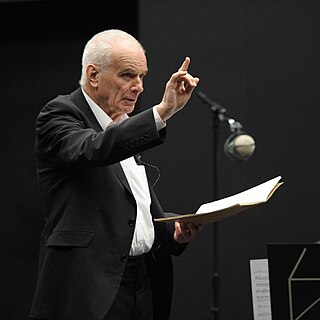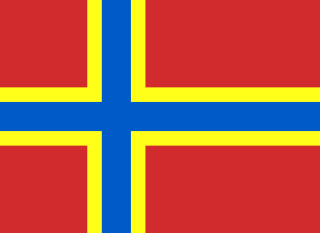
Harald Fairhair was a Norwegian king. According to traditions current in Norway and Iceland in the eleventh and twelfth centuries, he reigned from c. 872 to 930 and was the first King of Norway. Supposedly, two of his sons, Eric Bloodaxe and Haakon the Good, succeeded Harald to become kings after his death.

The Orkneyinga saga is a narrative of the history of the Orkney and Shetland islands and their relationship with other local polities, particularly Norway and Scotland. The saga has "no parallel in the social and literary record of Scotland" and is "the only medieval chronicle to have Orkney as the central place of action". The main focus of the work is the line of jarls who ruled the Earldom of Orkney, which constituted the Norðreyjar or Northern Isles of Orkney and Shetland and there are frequent references to both archipelagoes throughout.

Saint Magnus Erlendsson, Earl of Orkney, sometimes known as Magnus the Martyr, was Earl of Orkney from 1106 to about 1117.

Stromness is the second-most populous town in Orkney, Scotland. It is in the southwestern part of Mainland Orkney. It is a burgh with a parish around the outside with the town of Stromness as its capital.

The Menai Strait is a strait which separates the island of Anglesey from Gwynedd, on the mainland of Wales. It is situated between Caernarfon Bay in the south-west and Conwy Bay in the north-east, which are both inlets of the Irish Sea. The strait is about 25 km (16 mi) long and varies in width from 400 metres (1,300 ft) between Fort Belan and Abermenai Point to 7.5 kilometres (4.7 mi) between Puffin Island and Penmaenmawr. It contains several islands, including Church Island, on which is located St Tysilio's Church.

Sir Peter Maxwell Davies was an English composer and conductor, who in 2004 was made Master of the Queen's Music.

George Mackay Brown was a Scottish poet, author and dramatist with a distinctly Orcadian character. He is widely regarded as one of the great Scottish poets of the 20th century.
Humans have inhabited Orkney, an archipelago in the north of Scotland, for about 8,800 years: Archeological evidence dates from Mesolithic times. Scandinavian clans dominated the area from the 8th century CE, using the islands as a base for further incursions. In the late 14th century the archipelago became part of Scotland.

St Magnus Cathedral dominates the skyline of Kirkwall, the main town of Orkney, a group of islands off the north coast of mainland Scotland. It is the oldest cathedral in Scotland, and the most northerly cathedral in the United Kingdom, a fine example of Romanesque architecture built for the bishops of Orkney when the islands were ruled by the Norse Earls of Orkney. It is owned not by the church, but by the burgh of Kirkwall as a result of an act of King James III of Scotland following Orkney's annexation by the Scottish Crown in 1468. It has its own dungeon.

The Earldom of Orkney was a Norse territory ruled by the earls of Orkney from the ninth century until 1472. It was founded during the Viking Age by Viking raiders and settlers from Scandinavia. In the ninth and tenth centuries it covered the Northern Isles (Norðreyjar) of Orkney and Shetland, as well as Caithness and Sutherland on the mainland. It was a dependent territory of the Kingdom of Norway until 1472, when it was absorbed into the Kingdom of Scotland. Originally, the title of Jarl or Earl of Orkney was heritable.
Thorfinn Sigurdsson, also known as Thorfinn the Mighty, was an 11th-century Jarl of Orkney. He was the youngest of five sons of Jarl Sigurd Hlodvirsson and the only one resulting from Sigurd's marriage to a daughter of Malcolm II of Scotland. He ruled alone as jarl for about a third of the time that he held the title and jointly with one or more of his brothers or with his nephew Rögnvald Brusason for the remainder. Thorfinn married Ingibiorg Finnsdottir, daughter of Finn Arnesson, Jarl of Halland.
Old Norse literature refers to the vernacular literature of the Scandinavian peoples up to c. 1350. It chiefly consists of Icelandic writings.
Magnús Óláfsson was a King of Mann and the Isles. He was a son of Óláfr Guðrøðarson, King of the Isles, and a member of the Crovan dynasty. Magnús' realm encompassed Mann and parts of the Hebrides. Some leading members of Magnús' family—such as his father—styled themselves "King of the Isles"; other members—such as Magnús and his brothers—styled themselves "King of Mann and the Isles". Although kings in their own right, leading members of the Crovan dynasty paid tribute to the Kings of Norway and generally recognised a nominal Norwegian overlordship of Mann and the Hebrides. Magnus was driven out by King Alexander III.
Paul Thorfinnsson and Erlend Thorfinnsson were brothers who ruled together as Earls of Orkney. Paul and Erlend were the sons of Thorfinn Sigurdsson and Ingibiorg Finnsdottir. Through Ingibiorg's father Finn Arnesson and his wife, the family was related to the Norwegian Kings Olav II and Harald II. They are both described as "tall, handsome men, shrewd and gentle, taking rather more after their mother's side of the family. Their lives and times are recounted in the Orkneyinga Saga, which was first written down in the early 13th century by an unknown Icelandic author.
Haakon Paulsson was a Norwegian jarl who ruled the earldom of Orkney together with his cousin Magnus Erlendsson from 1105 to 1123. Their lives and times are recounted in the Orkneyinga saga, which was first written down in the early 13th century by an unknown Icelandic author.

Orcadians, also known as Orkneymen, are an ethnic group native to the Orkney Islands, who speak an Orcadian dialect of the Scots language, a West Germanic language, and share a common history, culture and ancestry. Speaking Norn, a native North Germanic language into the 19th or 20th century, Orcadians descend significantly from North Germanic peoples, with around a third of their ancestry derived from Scandinavia, including a majority of their patrilineal line. According to anthropological study, the Orcadian ethnic composition is similar to that of Icelandic people; a comparable islander ethnicity of North Germanic origin.
Sweyn Asleifsson or Sveinn Ásleifarson was a twelfth-century Viking who appears in the Orkneyinga Saga.

The Martyrdom of St Magnus is a chamber opera in one act by the British composer Peter Maxwell Davies. The libretto, by Davies himself, is based on the novel Magnus by George Mackay Brown. The opera was first performed in St Magnus Cathedral, Kirkwall, Orkney on 18 June 1977.

St Magnus Church is a ruined medieval round-tower church located on the island of Egilsay, in Orkney, Scotland. The site is recognized as the place of execution of Saint Magnus Erlendsson, Earl of Orkney, in the 12th century. The roofless structure dates back to the 12th century, and has been described by Historic Environment Scotland (HES) as second only to St Magnus Cathedral, Kirkwall, as a surviving Norse church in Scotland.
Helga Moddansdóttir was the mistress of Haakon Paulsson who was Earl of Orkney from 1105 to 1123.











